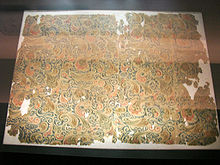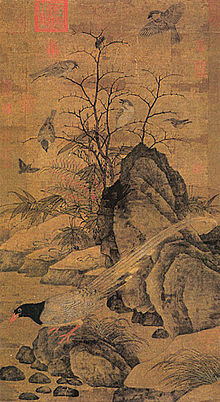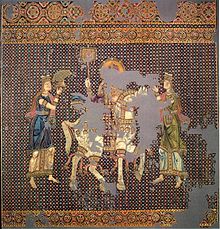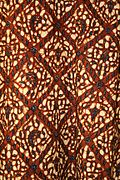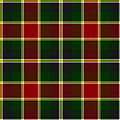- Silk
-
This article is about a natural fiber and the textile woven from it. For other uses, see Silk (disambiguation).
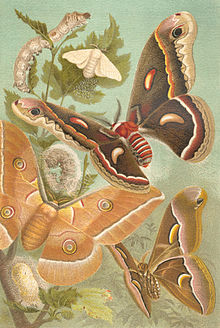 Four of the most important domesticated silk worms, together with their adult moth forms, Meyers Konversations-Lexikon (1885-1892)
Four of the most important domesticated silk worms, together with their adult moth forms, Meyers Konversations-Lexikon (1885-1892)
Silk is a natural protein fiber, some forms of which can be woven into textiles. The best-known type of silk is obtained from the cocoons of the larvae of the mulberry silkworm Bombyx mori reared in captivity (sericulture). The shimmering appearance of silk is due to the triangular prism-like structure of the silk fiber, which allows silk cloth to refract incoming light at different angles, thus producing different colors.
Silks are produced by several other insects, but only the silk of moth caterpillars has been used for textile manufacturing. There has been some research into other silks, which differ at the molecular level.[1] Silks are mainly produced by the larvae of insects undergoing complete metamorphosis, but also by some adult insects such as webspinners. Silk production is especially common in the Hymenoptera (bees, wasps, and ants), and is sometimes used in nest construction. Other types of arthropod produce silk, most notably various arachnids such as spiders (see spider silk).
Contents
History
Main article: History of silkWild silk
A variety of wild silks, produced by caterpillars other than the mulberry silkworm have been known and used in China, South Asia, and Europe since ancient times. However, the scale of production was always far smaller than that of cultivated silks. There are several reasons for this: one, they differ from the domesticated varieties in color and texture and are therefore less uniform, secondarily, cocoons gathered in the wild have usually had the pupa emerge from them before being discovered so the silk thread that makes up the cocoon has been torn into shorter lengths, and thirdly, many wild cocoons are covered in a mineral layer that stymies attempts to reel from them long strands of silk.[2] Thus previously the only way to obtain silk suitable for spinning into textiles in areas where commercial silks are not cultivated is by tedious and labor intensive carding.
Commercial silks originate from reared silkworm pupae which are killed by dipping them in boiling water before the adult moths emerge or by piercing them with a needle, and have been bred for a white color and no mineral on the surface, factors all contributing to the ability of whole cocoon to be unravelled as one continuous thread. This permits a much stronger cloth to be woven from the silk. Wild silks also tend to be more difficult to dye than silk from the cultivated silkworm.[3][4] A technique known as demineralizing allows the mineral layer around the cocoon to be removed,[5] leaving only variability in color as a barrier from creating a commercial silk industry based on wild silks in parts of the world where wild silkmoths thrive, such as Africa and South America.
China
Silk fabric was first developed in ancient China,[6] with some of the earliest examples found as early as 3500 BC.[7] Legend gives credit for developing silk to a Chinese empress, Leizu (Hsi-Ling-Shih, Lei-Tzu). Silks were originally reserved for the Kings of China for their own use and gifts to others, but spread gradually through Chinese culture and trade both geographically and socially, and then to many regions of Asia. Silk rapidly became a popular luxury fabric in the many areas accessible to Chinese merchants because of its texture and luster. Silk was in great demand, and became a staple of pre-industrial international trade. In July 2007, archeologists discovered intricately woven and dyed silk textiles in a tomb in Jiangxi province, dated to the Eastern Zhou Dynasty roughly 2,500 years ago.[8] Although historians have suspected a long history of a formative textile industry in ancient China, this find of silk textiles employing "complicated techniques" of weaving and dyeing provides direct and concrete evidence for silks dating before the Mawangdui-discovery and other silks dating to the Han Dynasty (202 BC-220 AD).[8]
The first evidence of the silk trade is the finding of silk in the hair of an Egyptian mummy of the 21st dynasty, c.1070 BC.[9] Ultimately the silk trade reached as far as the Indian subcontinent, the Middle East, Europe, and North Africa. This trade was so extensive that the major set of trade routes between Europe and Asia has become known as the Silk Road. The highest development was in China.
The Emperors of China strove to keep knowledge of sericulture secret to maintain the Chinese monopoly. Nonetheless sericulture reached Korea around 200 BC, about the first half of the 1st century AD had reached ancient Khotan,[10] and by AD 140 the practice had been established in India.[11]
In ancient era, silk from China was the most lucrative and sought-after luxury item traded across the Eurasian continent,[12] and many civilizations, such as the ancient Persians, benefited economically from trade.[12]
Thailand
Main article: Thai silkWoven silk from Cambodia
Silk is produced, year round, in Thailand by two types of silkworms, the cultured Bombycidae and wild Saturniidae. Most production is after the rice harvest in the southern and northeast parts of the country. Women traditionally weave silk on hand looms, and pass the skill on to their daughters as weaving is considered to be a sign of maturity and eligibility for marriage. Thai silk textiles often use complicated patterns in various colours and styles. Most regions of Thailand have their own typical silks. A single thread filament is too thin to use on its own so women combine many threads to produce a thicker, usable fiber. They do this by hand-reeling the threads onto a wooden spindle to produce a uniform strand of raw silk. The process takes around 40 hours to produce a half kilogram of Thai silk.
Many local operations use a reeling machine for this task, but some silk threads are still hand-reeled. The difference is that hand-reeled threads produce three grades of silk: two fine grades that are ideal for lightweight fabrics, and a thick grade for heavier material.
The silk fabric is soaked in extremely cold water and bleached before dyeing to remove the natural yellow coloring of Thai silk yarn. To do this, skeins of silk thread are immersed in large tubs of hydrogen peroxide. Once washed and dried, the silk is woven on a traditional hand operated loom.[13]
India
Main article: Silk in the Indian subcontinent Women in Assam rearing silkworms.
Women in Assam rearing silkworms.
Silk, known as "Paat" in Eastern India, Pattu in southern parts of India and Resham in Hindi/Urdu, has a long history in India. Recent archaeological discoveries in Harappa and Chanhu-daro suggest that sericulture, employing wild silk threads from native silkworm species, existed in South Asia during the time of the Indus Valley Civilization, roughly contemporaneous with the earliest known silk use in China.[14] According to an article in Nature by Philip Ball, while there is fast evidence for silk production in China back to around 2570 BC, newly discovered silk objects from the Indus valley in eastern Pakistan are believed to date from between 2450 BC and 2000 BC, "making them similarly ancient".[15] Shelagh Vainker, a silk expert at the Ashmolean Museum in Oxford, sees evidence for silk production in China "significantly earlier" than 2500–2000 BC, however suggests "people of the Indus civilization either harvested silkworm cocoons or traded with people who did, and that they knew a considerable amount about silk."[15] Silk is widely produced today. India is the second largest producer of silk after China. A majority of the silk in India is produced in Karnataka State, particularly in Mysore and the North Bangalore regions of Muddenahalli, Kanivenarayanapura, and Doddaballapur.[16] India is also the largest consumer of silk in the world. The tradition of wearing silk sarees in marriages by the brides is followed in southern parts of India. Silk is worn by people as a symbol of royalty while attending functions and during festivals. Historically silk was used by the upper classes, while cotton was used by the poorer classes. Today silk is mainly produced in Bhoodhan Pochampally (also known as Silk City), Kanchipuram, Dharmavaram, Mysore, etc. in South India and Banaras in the North for manufacturing garments and sarees. "Murshidabad silk", famous from historical times, is mainly produced in Malda and Murshidabad district of West Bengal and woven with hand looms in Birbhum and Murshidabad district. Another place famous for production of silk is Bhagalpur. The silk from Pochampally[disambiguation needed
 ] is particularly well-known for its classic designs and enduring quality. The silk is traditionally hand-woven and hand-dyed and usually also has silver threads woven into the cloth. Most of this silk is used to make sarees. The sarees usually are very expensive and vibrant in color. Garments made from silk form an integral part of Indian weddings and other celebrations. In the northeastern state of Assam, three different types of silk are produced, collectively called Assam silk: Muga, Eri and Pat silk. Muga, the golden silk, and Eri are produced by silkworms that are native only to Assam. The heritage of silk rearing and weaving is very old and continues today especially with the production of Muga and Pat riha and mekhela chador, the three-piece silk sarees woven with traditional motifs. Mysore Silk Sarees, which are known for their soft texture, last many years if carefully maintained.
] is particularly well-known for its classic designs and enduring quality. The silk is traditionally hand-woven and hand-dyed and usually also has silver threads woven into the cloth. Most of this silk is used to make sarees. The sarees usually are very expensive and vibrant in color. Garments made from silk form an integral part of Indian weddings and other celebrations. In the northeastern state of Assam, three different types of silk are produced, collectively called Assam silk: Muga, Eri and Pat silk. Muga, the golden silk, and Eri are produced by silkworms that are native only to Assam. The heritage of silk rearing and weaving is very old and continues today especially with the production of Muga and Pat riha and mekhela chador, the three-piece silk sarees woven with traditional motifs. Mysore Silk Sarees, which are known for their soft texture, last many years if carefully maintained.Ancient Mediterranean
In the Odyssey, 19.233, when Odysseus, while pretending to be someone else, is questioned by Penelope about her husband's clothing, he says that he wore a shirt "gleaming like the skin of a dried onion" (varies with translations, literal translation here)[17] which could refer to the lustrous quality of silk fabric. The Roman Empire knew of and traded in silk, and Chinese silk was the most highly priced luxury good imported by them.[12] During the reign of emperor Tiberius, sumptuary laws were passed that forbade men from wearing silk garments, but these proved ineffectual.[18] Despite the popularity of silk, the secret of silk-making only reached Europe around AD 550, via the Byzantine Empire. Legend has it that monks working for the emperor Justinian I smuggled silkworm eggs to Constantinople in hollow canes from China. All top-quality looms and weavers were located inside the Palace complex in Constantinople and the cloth produced was used in imperial robes or in diplomacy, as gifts to foreign dignitaries. The remainder was sold at very high prices.
Middle East
 Purchasing silkworm cocoons in Antioch, circa 1895.
Purchasing silkworm cocoons in Antioch, circa 1895.
In Islamic teachings, Muslim men are forbidden to wear silk. Many religious jurists believe the reasoning behind the prohibition lies in avoiding clothing for men that can be considered feminine or extravagant.[19] There are disputes regarding the amount of silk a fabric can consist of (e.g., whether a small decorative silk piece on a cotton caftan is permissible or not) for it to be lawful for men to wear but the dominant opinion of most Muslim scholars is that the wearing of silk for men is forbidden. Modern attire has raised a number of issues, including (for instance) the permissibility of wearing silk ties (which are of course very much masculine articles of clothing).
Despite injunctions against silk for men, silk has retained its popularity in the Islamic world because of its permissibility for women. The Muslim Moors brought silk with them to Spain during their conquest of the Iberian Peninsula.
Medieval and modern Europe
James I attempted to establish silk production in England, purchasing and planting 100,000 mulberry trees, some on land adjacent to Hampton Court Palace, but they were of a species unsuited to the silk worms, and the attempt failed. in 1732 John Guardivaglio set up a silk throwing enterprise at Logwood mill in Stockport, and in 1744, Burton Mill was erected in Macclesfield and in 1753 Old Mill was built in Congleton.[20] These three towns remained the centre of the English silk throwing industry until silk throwing was replaced by silk waste spinning. British enterprise also established silk filature in Cyprus in 1928. In England in the mid 20th Century, raw silk was produced at Lullingstone Castle in Kent. Silkworms were raised and reeled under the direction of Zoe Lady Hart Dyke. Production started elsewhere later.
Italy was the most important producer of silk during the Medieval age. One notable center was the italian city-state of Lucca which largely financed itself through silk-production and silk-trading, beginning in the 12th Century. Other italian cities involved in silk production were Genoa, Venice and Florence.
In France, since the 15th century silk production was centered around the city of Lyon where many mechanic tools for mass production were first introduced in the 17th century.
North America
James I of England introduced silk-growing to the American colonies around 1619, ostensibly to discourage tobacco planting. The Shakers in Kentucky adopted the practice as did a cottage industry in New England.[21] In the 19th century a new attempt at a silk industry began with European-born workers in Paterson, New Jersey, and the city became a US silk center, although Japanese imports were still more important.
World War II interrupted the silk trade from Japan. Silk prices increased dramatically, and US industry began to look for substitutes, which led to the use of synthetics such as nylon. Synthetic silks have also been made from lyocell, a type of cellulose fiber, and are often difficult to distinguish from real silk (see spider silk for more on synthetic silks).
Properties
Physical properties
Silk fibers from the Bombyx mori silkworm have a triangular cross section with rounded corners, 5-10 μm wide. The fibroin-heavy chain is composed mostly of beta-sheets, due to a 59-mer amino acid repeat sequence with some variations.[22] The flat surfaces of the fibrils reflect light at many angles, giving silk a natural shine. The cross-section from other silkworms can vary in shape and diameter: crescent-like for Anaphe and elongated wedge for tussah. Silkworm fibers are naturally extruded from two silkworm glands as a pair of primary filaments (brin), which are stuck together, with sericin proteins that act like glue, to form a bave. Bave diameters for tussah silk can reach 65 μm. See cited reference for cross-sectional SEM photographs.[23]
Silk has a smooth, soft texture that is not slippery, unlike many synthetic fibers.
Silk is one of the strongest natural fibers but loses up to 20% of its strength when wet. It has a good moisture regain of 11%. Its elasticity is moderate to poor: if elongated even a small amount, it remains stretched. It can be weakened if exposed to too much sunlight. It may also be attacked by insects, especially if left dirty.
Silk is a poor conductor of electricity and thus susceptible to static cling.
Unwashed silk chiffon may shrink up to 8% due to a relaxation of the fiber macrostructure. So silk should either be washed prior to garment construction, or dry cleaned. Dry cleaning may still shrink the chiffon up to 4%. Occasionally, this shrinkage can be reversed by a gentle steaming with a press cloth. There is almost no gradual shrinkage nor shrinkage due to molecular-level deformation.
Natural and synthetic silk is known to manifest piezoelectric properties in proteins, probably due to its molecular structure.[24]
Silkworm silk was used as the standard for the denier, a measurement of linear density in fibers. Silkworm silk therefore has a linear density of approximately 1 den, or 1.1 dtex.
Comparison of silk fibers[25] Linear Density(dtex) Diameter (μm) Coeff. Variation Moth: Bombyx mori 1.17 12.9 24.8% Spider: Argiope aurentia 0.14 3.57 14.8% Chemical properties
Silk emitted by the silkworm consists of two main proteins, sericin and fibroin, fibroin being the structural center of the silk, and serecin being the sticky material surrounding it. Fibroin is made up of the amino acids Gly-Ser-Gly-Ala-Gly-Ala and forms beta pleated sheets. Hydrogen bonds form between chains, and side chains form above and below the plane of the hydrogen bond network.
The high proportion (50%) of glycine, which is a small amino acid, allows tight packing and the fibers are strong and resistant to breaking. The tensile strength is due to the many interseeded hydrogen bonds, and when stretched the force is applied to these numerous bonds and they do not break.
Silk is resistant to most mineral acids, except for sulfuric acid, which dissolves it. It is yellowed by perspiration.
Uses
Silk's absorbency makes it comfortable to wear in warm weather and while active. Its low conductivity keeps warm air close to the skin during cold weather. It is often used for clothing such as shirts, ties, blouses, formal dresses, high fashion clothes, lingerie, pyjamas, robes, dress suits, sun dresses and Eastern folk costumes. Silk's attractive lustre and drape makes it suitable for many furnishing applications. It is used for upholstery, wall coverings, window treatments (if blended with another fiber), rugs, bedding and wall hangings.[citation needed] While on the decline now, due to artificial fibers, silk has had many industrial and commercial uses; parachutes, bicycle tires, comforter filling and artillery gunpowder bags.[citation needed]
A special manufacturing process removes the outer irritant sericin coating of the silk, which makes it suitable as non-absorbable surgical sutures. This process has also recently led to the introduction of specialist silk underclothing for children and adults with eczema where it can significantly reduce itch.[citation needed] New uses and manufacturing techniques have been found for silk for making everything from disposable cups to drug delivery systems and holograms.[26] To produce 1 kg of silk, 104 kg of mulberry leaves must be eaten by 3000 silkworms. It takes about 5000 silkworms to make a pure silk kimono.[27]:104 The construction of silk is called sericulture. The major silk producers are China (54%) and India (14%).
Top Ten Cocoons (Reelable) Producers — 2005 Country Production (Int $1000) Footnote Production (1000 kg) Footnote  People's Republic of China
People's Republic of China978,013 C 290,003 F  India
India259,679 C 77,000 F  Uzbekistan
Uzbekistan57,332 C 17,000 F  Brazil
Brazil37,097 C 11,000 F  Iran
Iran20,235 C 6,088 F  Thailand
Thailand16,862 C 5,000 F  Vietnam
Vietnam10,117 C 3,000 F  Democratic People's Republic of Korea
Democratic People's Republic of Korea5,059 C 1,500 F  Romania
Romania3,372 C 1,000 F  Japan
Japan2,023 C 600 F No symbol = official figure, F = FAO estimate, * = Unofficial figure, C = Calculated figure;
Production in Int $1000 have been calculated based on 1999-2001 international prices
Source: Food And Agricultural Organization of United Nations: Economic And Social Department: The Statistical DivisionCultivation
Silk moths lay eggs on specially prepared paper. The eggs hatch and the caterpillars (silkworms) are fed fresh mulberry leaves. After about 35 days and 4 moltings, the caterpillars are 10,000 times heavier than when hatched and are ready to begin spinning a cocoon. A straw frame is placed over the tray of caterpillars, and each caterpillar begins spinning a cocoon by moving its head in a "figure 8" pattern. Two glands produce liquid silk and force it through openings in the head called spinnerets. Liquid silk is coated in sericin, a water-soluble protective gum, and solidifies on contact with the air. Within 2–3 days, the caterpillar spins about 1 mile of filament and is completely encased in a cocoon. The silk farmers then kill most caterpillars by heat, leaving some to metamorphose into moths to breed the next generation of caterpillars. Harvested cocoons are then soaked in boiling water to soften the sericin holding the silk fibers together in a cocoon shape. The fibers are then unwound to produce a continuous thread. Since a single thread is too fine and fragile for commercial use, anywhere from three to ten strands are spun together to form a single thread of silk.[28]
Research
Dr Willy Tan, a Republic Polytechnic researcher, is "leading a project that coaxes silkworms to spin stronger silk by exposing them to an electric field before they spin."[29] The collaborative work between Republic Polytechnic and National University of Singapore aims to produce "super" silk which has a number of advantages over carbon/glass fibers and Kevlar.[30]
Dr Natalia Tansil has led a research program into a "new, more environmentally friendly method allows us to integrate colours into the very fabric of silk and does away with the need for manual dyeing." The study conducted at Singapore's Institute of Materials Research and Engineering (IMRE) involves introducing safe, luminescent dyes into the food of the silkworm in the last four days of its larval stage, which has enabled the researchers to produce brightly coloured silk that isn't nearly as wasteful as conventional dyeing methods.[31]
Animal rights
As the process of harvesting the silk from the cocoon kills the larvae, sericulture has been criticized in the early 21st century by PETA.[32] Mohandas Gandhi was also critical of silk production based on the Ahimsa philosophy "not to hurt any living thing." This led to Gandhi's promotion of cotton spinning machines, an example of which can be seen at the Gandhi Institute. He also promoted Ahimsa silk, wild silk made from the cocoons of wild and semi-wild silk moths.[33] Ahimsa silk is promoted in parts of Southern India for those who prefer not to wear silk produced by killing silkworms.[34][35]
See also
- Art silk
- Byzantine silk
- History of silk
- Mommes, the traditional density unit for silk.
- Rayon
- Silk in the Indian subcontinent
- Silk Road
- Silk waste
- Spider silk (with a discussion of synthetic silk)
- Tenun Pahang Diraja, famous woven silk fabric of Pahang, Malaysia.
- Thai silk
References
- Notes
- ^ Sutherland TD, Young JH, Weisman S, Hayashi CY, Merritt DJ (2010). "Insect silk: one name, many materials". Annual Review of Entomology 55: 171–88. doi:10.1146/annurev-ento-112408-085401. PMID 19728833. http://arjournals.annualreviews.org/doi/full/10.1146/annurev-ento-112408-085401?url_ver=Z39.88-2003&rfr_id=ori:rid:crossref.org&rfr_dat=cr_pub%3dpubmed.
- ^ Sindya N. Bhanoo (20 May 2011). "Silk Production Takes a Walk on the Wild Side". New York Times. http://www.nytimes.com/2011/05/24/science/24obsilk.html?_r=3&emc=eta1. Retrieved 26 May 2011.
- ^ Hill (2004). Appendix E.
- ^ Hill (2009), "Appendix C: Wild Silks," pp.477-480.
- ^ Gheysens, T; Collins, A; Raina, S; Vollrath, F; Knight, D (2011). "Demineralization enables reeling of Wild Silkmoth cocoons". Biomacromolecules (American Chemical Society). doi:10.1021/bm2003362. http://pubs.acs.org/doi/abs/10.1021/bm2003362. Retrieved 26 May 2011.
- ^ "Silk: History". Columbia Encyclopedia Sixth Edition. http://www.infoplease.com/ce6/society/A0861091.html.
- ^ "Textile Exhibition: Introduction". Asian art. http://www.asianart.com/textiles/intro.html.
- ^ a b "Chinese archaeologists make ground-breaking textile discovery in 2,500-year-old tomb". People's Daily Online.. http://english.people.com.cn/90001/90782/6228297.html. Retrieved 2007-08-26.
- ^ Lubec, G.; J. Holaubek, C. Feldl, B. Lubec, E. Strouhal (1993-03-04). "Use of silk in ancient Egypt". Nature 362 (6415): 25. doi:10.1038/362025b0. (also available here [1])
- ^ *Hill, John E. (2009) Through the Jade Gate to Rome: A Study of the Silk Routes during the Later Han Dynasty, 1st to 2nd Centuries CE. BookSurge, Charleston, South Carolina. ISBN 978-1-4392-2134-1. Appendix A: "Introduction of Silk Cultivation to Khotan in the 1st Century CE," pp. 466-467.
- ^ "History of Sericulture". Governmentof Andhra Pradesh (India) - Department of Sericulture. http://www.seri.ap.gov.in/download/1_History%20of%20Sericulture.pdf. Retrieved 7 November 2010.
- ^ a b c Garthwaite, Gene Ralph (2005). The Persians. Oxford & Carlton: Blackwell Publishing, Ltd. p. 78. ISBN 1557868603.
- ^ About Thai silk from World of Thai Silk (commercial)
- ^ Good, I.L.; Kenoyer, J.M.; Meadow, R.H. (2009). "New evidence for early silk in the Indus civilization". Archaeometry 50: 457. doi:10.1111/j.1475-4754.2008.00454.x.
- ^ a b http://www.nature.com/news/2009/090217/full/457945a.html
- ^ Silk city to come up near B’lore, Deccan Herald, 16 October 2009.
- ^ Odyssey 19 233-234: τὸν δὲ χιτῶν' ἐνόησα περὶ χροῒ σιγαλόεντα, οἷόν τε κρομύοιο λοπὸν κάτα ἰσχαλέοιο· = "And I [= Odysseus
- ^ Tacitus. Annals. ISBN 0521315433. http://www.gutenberg.org/etext/7959.
- ^ "Silk: Why It Is Haram for Men". 2003-09-23. Archived from the original on 2007-03-02. http://web.archive.org/web/20070302204114/http://www.islamonline.net/fatwa/english/FatwaDisplay.asp?hFatwaID=61261. Retrieved 2007-01-06.
- ^ Callendine 1993
- ^ "Mansfield Historical Society". 2008. http://www.mansfieldct-history.org/Industry/Silk/silk_production.shtml. Retrieved 2009-03-30.[dead link]
- ^ "Handbook of Fiber Chemistry", Menachem Lewin, Editor, 3rd ed., 2006, CRC press, ISBN 0-8247-2565-4
- ^ "Handbook of Fiber Chemistry", Menachem Lewin, Editor, 2nd ed.,1998, Marcel Dekker, pp. 438-441, ISBN 0-8247-9471-0
- ^ "Piezoelectricity in Natural and Synthetic Silks". http://fs.tx.ncsu.edu/Past_Meetings/Spring_2003_Loughborough/papers/081-Ellison.pdf. Retrieved 28 April 2010.
- ^ Frank K. Ko; Sueo Kawabata, Mari Inoue, Masako Niwa. "Engineering Properties of Spider Silk". http://web.mit.edu/course/3/3.064/www/slides/Ko_spider_silk.pdf. Retrieved 9 July 2010.
- ^ 10 minute video talk at TED by Fiorenzo Omenetto of Tufts University
- ^ Fritz, Anne and Cant, Jennifer (1986). Consumer Textiles. Oxford University Press Australia. Reprint 1987. ISBN 0 19 554647 4.
- ^ Carrie Gleason: The Biography of Silk, page 12. Crabtree Publishing Company 2007.
- ^ The Straits Times: Silk so strong you can turn it into bullet-proof vests
- ^ NUS: Creating "super" silk
- ^ Silkworms made to spin coloured silk, Australian Geographic, October 10, 2011.
- ^ "Down and Silk: Birds and Insects Exploited for Fabric". PETA. http://www.peta.org/mc/factsheet_display.asp?ID=121. Retrieved 2007-01-06.
- ^ "Mahatma Gandhi: 100 years", 1968, p. 349
- ^ Silk Moths Fly Free Kusuma Rajaiah's Ahimsa project.
- ^ Silk saree without killing a single silkworm Another article about Rajaiah and his methods.
- Bibliography
- Callandine, Anthony (1993). "Lombe's Mill: An Exercise in reconstruction". Industrial Archaeology Review (Maney Publishing) XVI (1). ISSN 0309-0728.
- Good, Irene. 1995. “On the question of silk in pre-Han Eurasia” Antiquity Vol. 69, Number 266, December 1995, pp. 959–968
- Hill, John E. 2004. The Peoples of the West from the Weilüe 魏略 by Yu Huan 魚豢: A Third Century Chinese Account Composed between 239 and 265 AD. Draft annotated English translation. Appendix E.
- Hill, John E. (2009) Through the Jade Gate to Rome: A Study of the Silk Routes during the Later Han Dynasty, 1st to 2nd Centuries CE. BookSurge, Charleston, South Carolina. ISBN 978-1-4392-2134-1.
- Kuhn, Dieter. 1995. “Silk Weaving in Ancient China: From Geometric Figures to Patterns of Pictorial Likeness.” Chinese Science 12 (1995): pp. 77–114.
- Liu, Xinru (1996). Silk and Religion: An Exploration of Material Life and the Thought of People, AD 600-1200. Oxford University Press.
- Liu, Xinru (2010). The Silk Road in World History. Oxford University Press. ISBN 978-0-19-516174-8; ISBN 978-0-19-533810-2 (pbk).
- Rayner, Hollins (1903). Silk throwing and waste silk spinning. Scott, Greenwood, Van Nostrand. http://openlibrary.org/books/OL7174062M/Silk_throwing_and_waste_silk_spinning.
- Sung, Ying-Hsing. 1637. Chinese Technology in the Seventeenth Century - T'ien-kung K'ai-wu. Translated and annotated by E-tu Zen Sun and Shiou-chuan Sun. Pennsylvania State University Press, 1966. Reprint: Dover, 1997. Chap. 2. Clothing materials.
- Kadolph, Sara J. Textiles. 10th ed. Upper Saddle River: Pearson Prentice Hall, 2007. 76-81.
External links
- Cocoon Silk: A Natural Architecture
- References to silk by Roman and Byzantine writers
- Sericulture in Asia: Yesterday, today, tomorrow, Asia and Pacific Network ;
- A series of maps depicting the global trade in silk
- History of traditional silk in martial arts uniforms
- Raising silkworms in classrooms for educational purposes (with photos)
- New thread in fabric of insect silks | physorg.com
- Fiorenzo Omenetto: Silk, the ancient material of the future
- Blood on silk
Fibers Natural 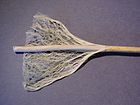
Synthetic CelluloseClothing Materials Tops Blouse · Crop top · Dress shirt · Halterneck · Henley shirt · Hoodie · Jersey · Guernsey · Poet shirt · Polo shirt · Shirt · Sleeveless shirt · Sleeveless sweater · Sweater · T-shirt · Tube top · Turtleneck · TwinsetTrousers or pants Bell-bottoms · Bermuda shorts · Bondage pants · Capri pants · Cargo pants · Culottes · Cycling shorts · Dress pants · Jeans · Jodhpurs · Overall · Parachute pants · Phat pants · Shorts · Sweatpants · WindpantsSkirts A-line skirt · Ballerina skirt · Fustanella · Hobble skirt · Jean skirt · Job skirt · Leather skirt · Kilt · Men's skirts · Microskirt · Miniskirt · Pencil skirt · Poodle skirt · Prairie skirt · Rah-rah skirt · Sarong · Skort · Slip · Train · WrapDresses Ball gown · Cocktail dress · Débutante dress · Evening gown · Gown · Jumper dress · Little black dress · Petticoat · Sari · Sundress · Tea gown · Wedding dress · Wrap dressSuits and uniforms Academic dress · Afrocentric suit · Black tie · Buddhist monastic robe · Clerical clothing · Court dress · Gymslip · Jumpsuit · Lab coat · Lounge suit · Mao suit · Morning dress · Pantsuit · Red Sea rig · Scrubs · Stroller · Tangzhuang · Tuxedo · White tieOuterwear Abaya · Academic gown · Anorak · Apron · Blazer · Cagoule · Cloak · Coat · Duffle coat · Duster · Frock coat · Jacket · Greatcoat · Leather jacket · Goggle jacket · Hoodie · Opera coat · Overcoat · Pea coat · Poncho · Raincoat · Redingote · Robe · Shawl · Shrug · Ski suit · Sleeved blanket · Sports coat · Top coat · Trench coat · Vest · Waistcoat · WindbreakerUnderwear Boxer briefs · Boxer shorts · Brassiere · Briefs · Bustle · Compression sportswear · Corselet · Corset · Diaper · Dickey · Lingerie · Loincloth · Long underwear · Panties · Teddy · Temple garment · Trunks · Undershirt · IzaarAccessories Ascot tie · Belly chain · Belt · Bolo tie · Bow tie · Chaps · Coin purse · Cufflink · Earring · Gaiters · Gloves · Hairpin · Handbag · Leg warmer · Leggings · Muff (handwarmer) · Necklace · Necktie · Scarf · Shoe buckle · Stocking · Sunglasses · Suspenders · TightsFootwear Athletic shoe · Boot · Court shoe · Dress shoe · Flip-flops · Hosiery · Sandal · Shoe · Slipper · SockHeadwear Nightwear Swimwear Bikini · Boardshorts · One-piece · Square leg suit · Swim briefs · Swim cap · Swim diaper · Swim trunks · WetsuitClothing parts Back closure · Buckle · Bustline · Button · Buttonhole · Collar · Cuff · Elastic · Fly · Hemline · Hook-and-eye · Lapel · Neckline · Pocket · Revers · Shoulder pad · Shoulder strap · Sleeve · Snap · Strap · Velcro · Waistline · ZipperNational costume Albanian dress · Abaya · Aboyne dress · Áo bà ba · Áo dài · Áo tứ thân · Batik · Baro't saya & Barong Tagalog · Bunad · Þjóðbúningurinn · Cheongsam (Qípáo) · Dashiki · Deel · Dhoti · Dirndl · Djellaba · Gákti · Gho & Kira · Han Chinese clothing · Hanbok · Highland dress · Jellabiya · Jilbāb · Kebaya · Kente cloth · Kilt · Kimono · Lederhosen · Sampot · Sarafan · Sari · Sarong · Shalwar kameez · Sherwani · ThawbHistorical garments Banyan · Bedgown · Bodice · Braccae · Breeches · Breeching · Brunswick · Caraco · Chemise · Cravat · Chiton · Chlamys · Close-bodied gown · Doublet · Exomis · Farthingale · Frock · Himation · Hose · Houppelande · Jerkin · Justacorps · Knickerbockers · Palla · Peplos · Polonaise · Sack-back gown · Smock-frock · Stola · Toga · TunicHistory and surveys See also Adaptive clothing · Clothing terminology · Costume · Dress code · Fashion · Formal wear · Ironing · Laundry · Locking clothing · Maternity clothing · Reversible garmentCategories:- Silk
- Woven fabrics
Wikimedia Foundation. 2010.

